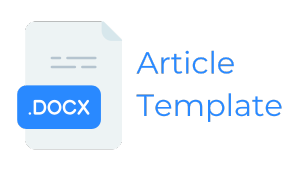Peer Review Process
The Bangladesh Journal of Advanced Clinical Research (BJACR) is committed to ensuring the publication of only high-quality, original, and ethically sound research. To achieve this, the journal follows a rigorous double-blind peer-review system, designed to uphold academic integrity, guarantee fairness, and ensure scientific accuracy. This structured process involves several carefully monitored stages, each aimed at safeguarding the journal’s standards of excellence.
- Submission and Initial Evaluation
- Manuscript Submission: Authors must submit manuscripts electronically through BJACR’s online submission portal. Each submission must include a cover letter clearly describing the novelty, clinical significance, and alignment with the journal’s aims and scope. Supplementary documents such as ethical approval certificates, patient consent forms (where applicable), and funding disclosures must also be uploaded.
- Initial Screening: The editorial office conducts a preliminary check for:
- Adherence to formatting and referencing guidelines.
- Completeness of submission (cover letter, tables, figures, supplementary files).
- Ethical compliance documentation (IRB approval, animal ethics approval, informed consent).
- Plagiarism screening using licensed similarity-check software. Manuscripts exceeding the journal’s acceptable similarity threshold are rejected immediately.
- Editorial Triage: The Editor-in-Chief or an assigned Senior Editor evaluates whether the manuscript fits the journal’s scope, demonstrates originality, and presents sufficient scientific merit. Manuscripts deemed unsuitable are rejected at this stage with constructive feedback.
- Assignment to an Editor
- Editor-in-Chief Screening: The Editor-in-Chief reviews the manuscript for novelty, research quality, potential impact, and clarity. Manuscripts with insufficient novelty or lacking methodological soundness may be declined at this point.
- Handling Editor Appointment: Suitable manuscripts are assigned to a Handling Editor with subject-area expertise. The Handling Editor manages the peer review process, selecting reviewers, monitoring progress, and communicating with authors.
- Peer Reviewer Selection
- Reviewer Identification: Two to three expert reviewers are selected based on subject expertise, prior publications, and professional reputation. In special cases, more than three reviewers may be invited for highly technical or multidisciplinary manuscripts.
- Conflict of Interest Declaration: Reviewers are required to disclose any real or perceived conflicts of interest (e.g., personal, financial, academic, or collaborative relationships with authors). Those with conflicts are not assigned.
- Reviewer Invitation: Formal invitations are sent outlining the manuscript’s title, abstract, and expected review timeline. Upon acceptance, reviewers gain full access to the blinded manuscript.
- Reviewer Database: BJACR maintains a reviewer database updated regularly to ensure diversity, inclusivity, and representation across specialties and geographic regions.
- Double-Blind Review
- Anonymity: To ensure impartiality, author identities are concealed from reviewers, and reviewer identities remain hidden from authors. This reduces bias based on nationality, gender, institution, or seniority.
- Evaluation Criteria: Reviewers are asked to evaluate manuscripts against the following criteria:
- Originality: Novelty of research question or approach.
- Methodological Rigor: Appropriateness and accuracy of study design, methods, and analysis.
- Ethical Compliance: Adequate ethical approvals, patient consent, and humane research practices.
- Clarity of Presentation: Logical structure, language quality, and data visualization.
- Significance: Relevance and contribution to clinical practice and scientific knowledge.
- Reviewer Report: Reviewers provide:
- A structured written report highlighting strengths, weaknesses, and required improvements.
- A confidential recommendation to the editor (accept, minor revision, major revision, or reject).
- Specific comments for authors and, if needed, confidential notes for the editor only.
- Editorial Decision
- Handling Editor Recommendation: The Handling Editor synthesizes reviewer feedback and prepares a recommendation. If reviewer opinions diverge significantly, additional reviewers may be consulted.
- Final Decision by Editor-in-Chief: The Editor-in-Chief makes the final decision based on reviewer input, Handling Editor advice, and the journal’s editorial standards.
- Decision Categories:
- Accept: Manuscript is accepted with minimal or no revisions.
- Minor Revision: Manuscript requires small changes before acceptance.
- Major Revision: Manuscript needs substantial revisions and may be re-reviewed.
- Reject: Manuscript is unsuitable due to lack of originality, methodological flaws, or irrelevance.
- Decision Communication: Authors receive a decision letter along with anonymized reviewer comments and guidance for revisions if applicable.
- Revision and Resubmission
- Author Revisions: Authors are required to address reviewer and editor comments point by point in a detailed response letter. All changes must be highlighted in the revised manuscript.
- Re-Review: Major revisions are often sent back to the original reviewers for further assessment. Minor revisions are usually checked by the Handling Editor.
- Resubmission Deadlines: Authors are expected to resubmit revisions within the timeframe provided (typically 2–4 weeks for minor revisions, 6–8 weeks for major revisions).
- Final Acceptance and Publication
- Final Quality Control: The editorial office checks formatting, references, figures, tables, and ethical documentation. Manuscripts not meeting requirements may be delayed.
- Proofing: Accepted manuscripts are typeset, and proof copies are sent to authors for final review. Authors must confirm accuracy within a set timeframe before publication.
- Open Access Publication: Final versions are published online under BJACR’s open-access policy and licensed with Creative Commons Attribution-NonCommercial (CC BY-NC). Articles are immediately available to the global community.
- Post-Publication Oversight
- Corrections and Retractions: If significant errors, misconduct, or ethical violations are identified after publication, BJACR will issue corrections, retractions, or expressions of concern in accordance with COPE guidelines.
- Post-Publication Peer Review: Readers may submit comments or letters to the editor regarding published articles. Such submissions may undergo peer review before being published as correspondence.
- Reviewer Recognition: Reviewers who consistently provide timely, high-quality, and constructive reviews may be recognized through:
- Certificates of appreciation.
- Annual acknowledgment in the journal.
- Invitations to join the Editorial Board or serve as Guest Editors.



















